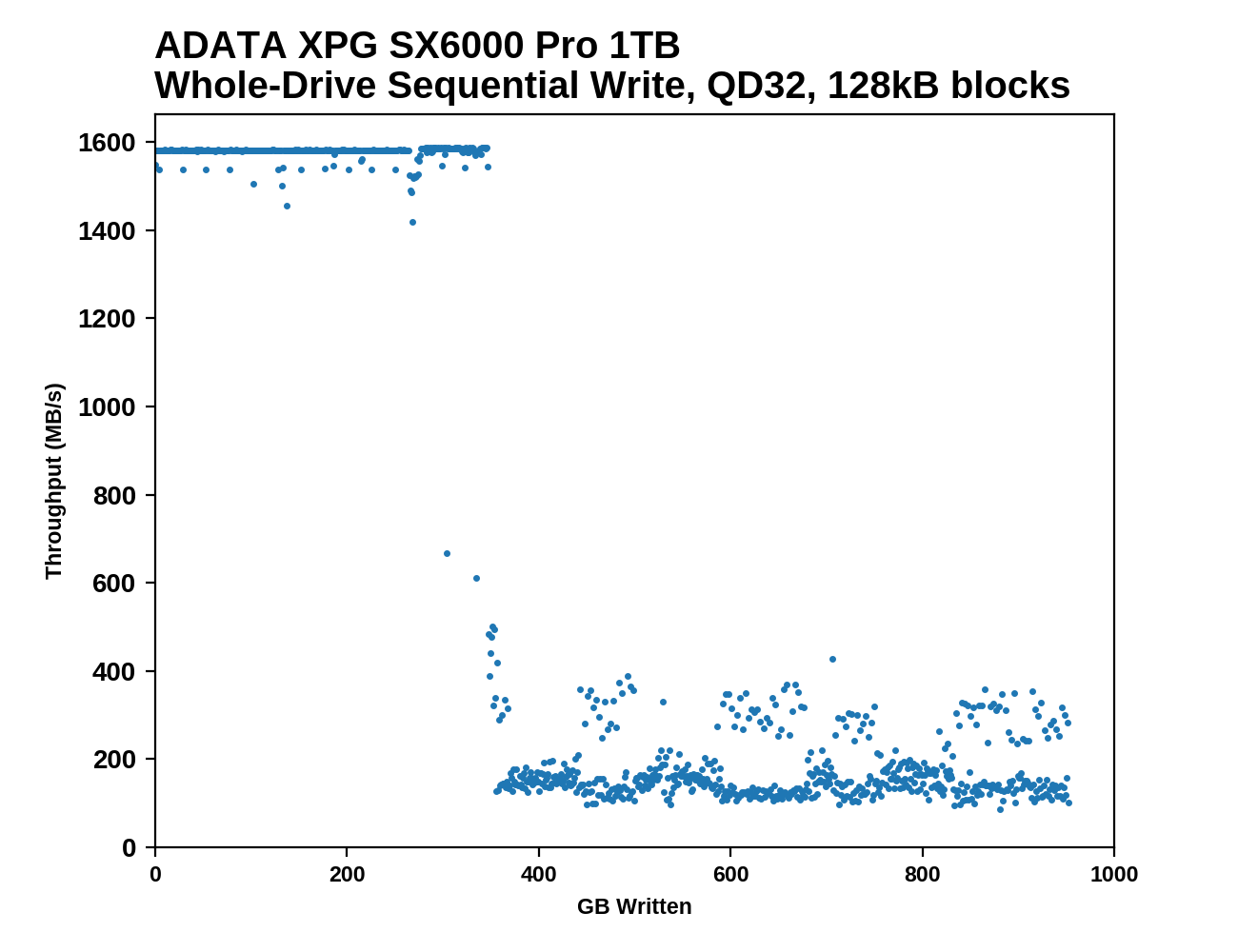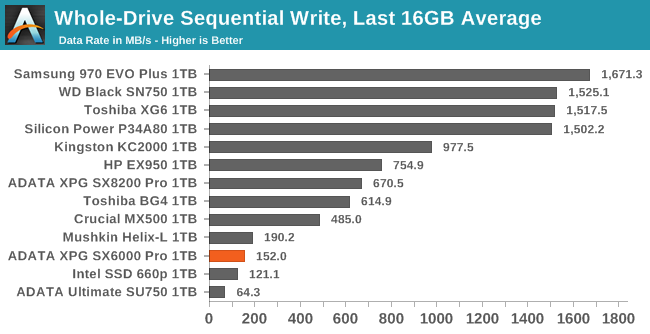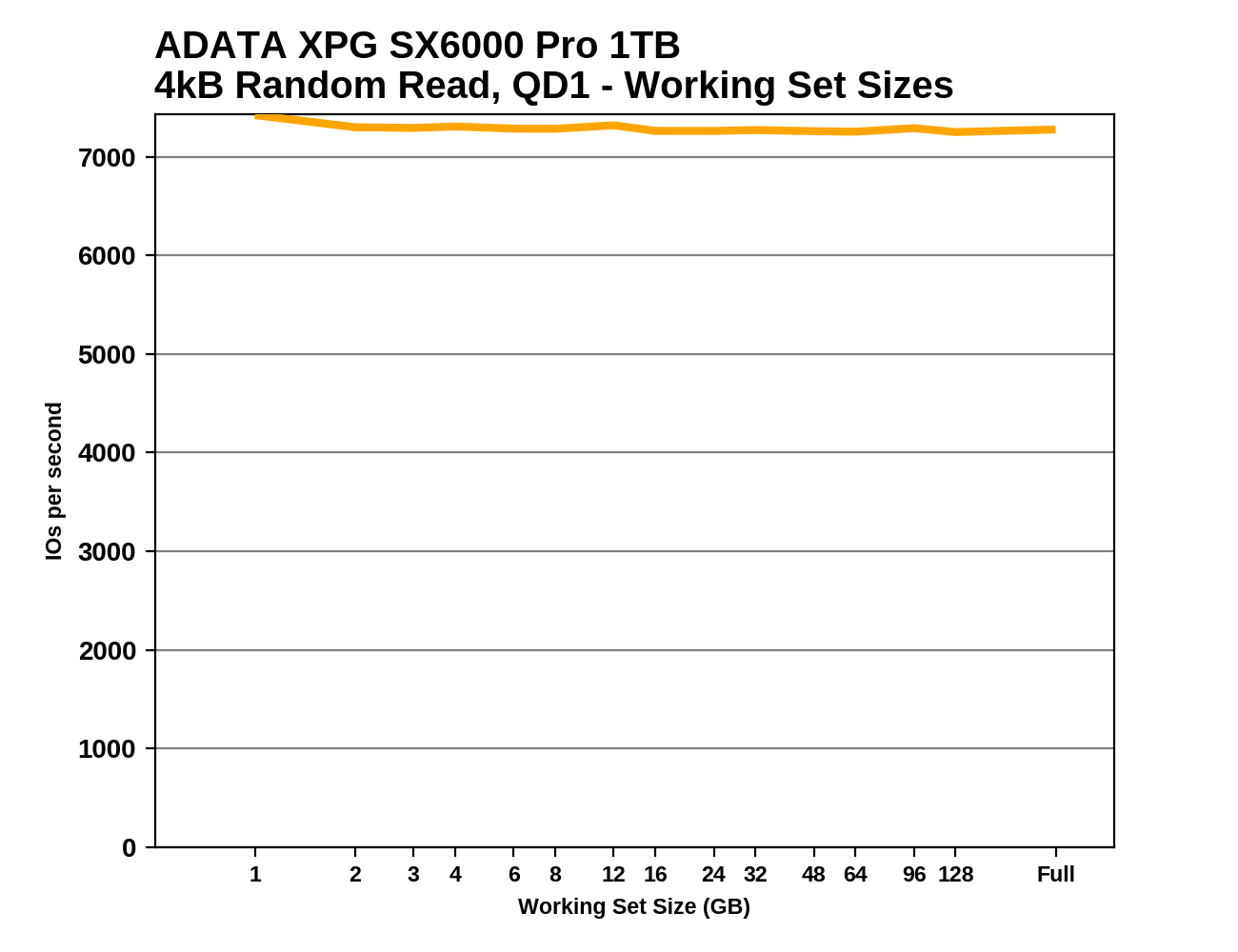The ADATA XPG SX6000 Pro 1TB SSD Review: Realtek's Entry-level NVMe Solution
by Billy Tallis on December 18, 2019 12:30 PM ESTWhole-Drive Fill
This test starts with a freshly-erased drive and fills it with 128kB sequential writes at queue depth 32, recording the write speed for each 1GB segment. This test is not representative of any ordinary client/consumer usage pattern, but it does allow us to observe transitions in the drive's behavior as it fills up. This can allow us to estimate the size of any SLC write cache, and get a sense for how much performance remains on the rare occasions where real-world usage keeps writing data after filling the cache.
 |
|||||||||
As with the Realtek-based ADATA SU750, the ADATA SX6000 Pro shows a large SLC cache and a sudden performance drop when it runs out. Since the SX6000 Pro's RTS5763DL controller is a 4-channel design compared to the 2-channel RTS5733, the post-SLC write speed is quite a bit faster than the SU750, but it's also less consistent. Aside from a few momentary drops during the SLC phase, the cache lasts for about 348GB of writes, which is pretty much the largest SLC cache size possible with 1TB of TLC NAND. The write speed to the SLC cache is just a hair faster than the advertised 1.5GB/s.
 |
|||||||||
| Average Throughput for last 16 GB | Overall Average Throughput | ||||||||
The post-SLC write speed from the SX6000 Pro is over twice as fast as the ADATA SU750 and is ahead of the Intel 660p, but is not up to the speed of the Mushkin Helix-L. And the Toshiba BG4 shows that DRAMless drives don't have to be anywhere near this slow; the BG4 is 3-4 times faster after its admittedly small SLC cache runs out.
Working Set Size
Most mainstream SSDs have enough DRAM to store the entire mapping table that translates logical block addresses into physical flash memory addresses. DRAMless drives only have small buffers to cache a portion of this mapping information. Some NVMe SSDs (the SX6000 Pro included) support the Host Memory Buffer feature and can borrow a piece of the host system's DRAM for this cache rather needing lots of on-controller memory.
When accessing a logical block whose mapping is not cached, the drive needs to read the mapping from the full table stored on the flash memory before it can read the user data stored at that logical block. This adds extra latency to read operations and in the worst case may double random read latency.
We can see the effects of the size of any mapping buffer by performing random reads from different sized portions of the drive. When performing random reads from a small slice of the drive, we expect the mappings to all fit in the cache, and when performing random reads from the entire drive, we expect mostly cache misses.
When performing this test on mainstream drives with a full-sized DRAM cache, we expect performance to be generally constant regardless of the working set size, or for performance to drop only slightly as the working set size increases.
 |
|||||||||
The ADATA SX6000 Pro shows very consistent QD1 random read performance regardless of the test's working set size, so it appears that it is not deriving any benefit from the NVMe Host Memory Buffer feature, unlike the Toshiba BG4. Nor do we see an obvious cache size effect from on-controller SRAM as with the WD Blue SN500. The SX6000 Pro is not alone in this; the Mushkin Helix-L with Silicon Motion's DRAMless NVMe controller also leaves us largely wondering how HMB earns its keep.










36 Comments
View All Comments
Samus - Wednesday, December 18, 2019 - link
I don’t think you are being critical enough of this drive. It is appallingly bad. It’s basically outclassed by SATA drives from years ago in almost every metric except sequential performance (where NVMe will naturally excel)But real world performance is terrible, power usage is high (and it has broken devsleep) and it isn’t very cheap. When you consider reliability is a total u known I’m struggling to imagine a single person who would consider this.
Billy Tallis - Wednesday, December 18, 2019 - link
Let me make it a bit clearer for you: https://www.anandtech.com/bench/product/2533?vs=22...The MX500 beats the SX6000 Pro on just ONE of those performance metrics. The picture's not that different if you compare against a Samsung SATA drive. Overall performance is clearly much better than a SATA SSD. It's not appallingly bad. It just isn't a high-end NVMe drive.
DPUser - Wednesday, December 18, 2019 - link
Appallingly Clearer. : )Alistair - Wednesday, December 18, 2019 - link
haha nice :)JoeyJoJo123 - Wednesday, December 18, 2019 - link
Based Billy Tallis *dabbing* on the n00bs in the comments section. FACTS don't care about your feelings, Samus. It's times like this I'm glad you can't edit your comments, since moments like these are eternalized forever.MFinn3333 - Wednesday, December 18, 2019 - link
To be fair, the Samsung 850 Pro does beat it in the sustained random read/writes, power efficiency of said read/writes and uses a lot less power while active idle.https://www.anandtech.com/bench/product/2310?vs=25...
(Blue is Samsung and Orange is ADATA because Samsung is blue in my mind).
To be fairer, the Samsung is at least five years old, costs three times as much if you can get it, and has an idle response that is 15X worse than the ADATA. The ADATA is clearly the better drive for 99% of the population.
The_Assimilator - Wednesday, December 18, 2019 - link
It's absolutely appallingly bad. You can't simply excuse broken power management with "the other vendors messed it up too", the point is that none of those other vendors have messed it up NOW. Realtek failed to learn from and avoid their competitors' mistake, and by doing so have introduced their controller with a handicap versus the same competitors. It's also both unproven, slower, and more expensive than older controllers that do have a known track record, so that's four strikes against the RTS5763DL.In contrast, drives using the two-year-old SM2263XT are faster, cheaper, and to be blunt, just better. There is thus no reason why anybody would ever choose a drive using RTS5763DL, and its complete failure to compete is only going to become more apparent once the next-gen SMI and Phison controllers arrive (and E12 products go EOL and get huge discounts).
In short, while not as bad as Realtek's attempt at a SATA SSD controller, the RTS5763DL is just a plain bad product that simply cannot be recommended in any way shape or form.
milli - Wednesday, December 18, 2019 - link
Well look at this one again then: https://images.anandtech.com/graphs/graph15139/sus...I've learned from real-life usage that this test is one of the most important metrics that you will notice in your day to day usage. The Realtek is by far the fastest cacheless NVMe controller out there in this test.
Also while the drive lacks DEVSLP, statements like "broken power management" are just false. The graphs clearly show that it cuts power in half in each state. Lacking DEVSLP does not equal broken power management. ADATA even clearly states this on their website.
gregassagraf - Wednesday, July 21, 2021 - link
well... I installed the xpg Gammix s41 which is based in the same microcontroller! I lost more than an hour of battery life in my laptop and now sleep mode is basically useless. One big mistake in my part was caring only about read and write speeds. I can't wait to replace this drive, its driving me mad!mark625 - Wednesday, December 18, 2019 - link
The HP EX950 1TB has been my favorite value/$ drive for a while, and it costs a whole $7 more than the SX6000 Pro. It whomps the XPG drive in almost every test, and in many tests it is more than twice as fast.In what possible scenario would the XPG drive be a smarter purchase than the HP? None that I can see. This review is way too forgiving.